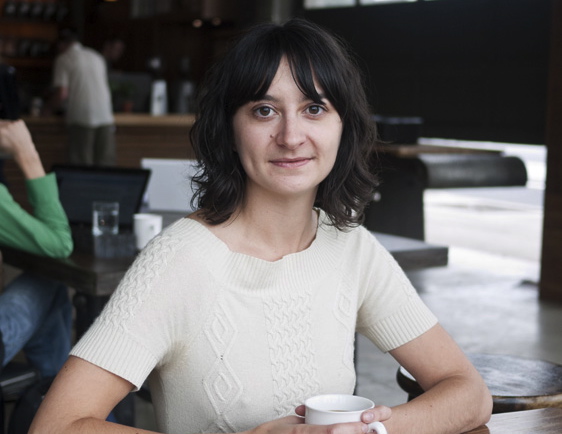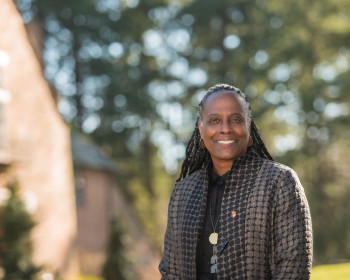Q&A with Hanna Neuschwander on her love for coffee and upcoming book
Open gallery

With her new book, Left Coast Roast, due out later this month, Lewis & Clark’s own Hanna Neuschwander is quickly becoming a local celebrity. The Source connected with Neuschwander, director of communications at the Graduate School of Education and Counseling, to learn more about her passion for coffee.
The launch party for Left Coast Roast is at the end of the month and will be open to the public. There will be special cocktails by Kelly Swenson BA ’05 (formerly the bartender at Ten 01 and June), coffee-inspired food on the menu, champagne, and a few special coffee beers, including a coffee IPA from Migration and a Belgian made with coffee cherry from Laurelwood. You can also watch local roasters duke it out with each other on the “Pop-a-Shot”—Spirit of 77’s custom race-against-the-clock basketball shootout.
Date: Monday, August 27
Time: 7 p.m. to 10 p.m.
Location: Spirit of 77 (500 N.E. Martin Luther King Jr. Boulevard, Portland)
How do you recommend people make a good cup of coffee at home?
I don’t think there’s any one right way to make coffee at home. Personal taste and the demands of your household are more important than anything else. Coffee is a very private pleasure in some ways—it’s our first companion in the morning, it’s a crutch we lean on to become ourselves. In that way, we tend to feel very strongly about what we like, to get into a groove with it and stick with the same thing. That’s totally okay, but most of us don’t even know what’s possible in terms of the flavors of coffee.
So if I had a coffee superpower, it would be to magically clear peoples’ schedules for an hour on a Sunday morning and teleport to their kitchens to set up a side-by-side tasting of different coffees. The variety in coffee is amazing. It’s endless. Lots of people think they love a really dark roasted coffee—because it’s what they know, it’s what’s comfortable—until they taste one side by side with something that’s roasted a bit lighter (assuming we’re talking high quality coffees here). Or they think they love a Sumatran, until they try something from Costa Rica.
As for myself, I make coffee usually one cup at a time with a little ceramic pour over. I think it cost $14 (we also have a nice burr grinder and an electric kettle to heat the water). I love that thing. It brews faster than an autodrip, and I have a lovely morning ritual with it that I completely rely upon to become human. It’s not just about caffeine—it’s all of my senses waking up. Feeling the steam rise, smelling those first whiffs of it, wrapping my perpetually cold hands around a warm mug. \
What are your top five picks for coffee?
I honestly can’t pick a favorite roaster, or cafe, or coffee. I think the thing that sets Portland apart from—and above—other coffee towns is the incredible variety we have. At my last count, there were over 40 companies roasting coffee in Portland, and a lot more than that selling their beans in cafes and grocery stores. If you twisted my arm, I could pick places that I love to return to again and again, because of some mix of the quality of the coffee, the design of the space, and the people: Coava, Stumptown’s Annex location, Extracto, the Red E, and Heart are all in the running. But there is so much more.
How do seasons affect coffee and the harvest schedule?
Coffee is a plant, and like all plants, it has seasonal rhythms. It grows in the equatorial belt almost exclusively, and depending on where in the world it’s growing, the harvest season may fall in our winter, spring, summer, or fall. This means that the coffees available at any given time on store shelves will change from season to season. Right now, coffees from Papua New Guinea and Timor, as well as Kenya (my favorite, in a pinch) will begin arriving any day. Coffees from Mexico, Guatemala, and elsewhere in Central America are just reaching the end of their season.
How long are coffee beans good for on the shelf?
In general, it takes about a month to three months after coffee is harvested for it to reach the U.S. From there, they have a solid shelf life of at least six months (before they are roasted—roasted coffee stales in a matter of weeks). But coffee shouldn’t be kept indefinitely. It is the product of a fruit, and it will degrade over time. (What we call the “bean” is actually the seed of a coffee cherry; when it’s first removed from the fruit, it’s not so different from a cherry pit).
It’s summer, and that means it’s time for iced coffee drinks for many people. What are the steps to making good cold brewed coffee?
There are two main approaches to iced coffee—the first is brewing it hot and pouring it over ice; the other is to brew it over a longer period of time using room temperature water. Normally, coffee is brewed in hot water—and there’s a good reason for this. There are lots of acids and other compounds in coffee that are only soluble in hot water. But the big upside of cold brewing is that it’s fairly stable—you can keep it in your fridge for a week and it’ll taste pretty much as good as it did when you first made it.
You can make cold brew in a brand-name cold brewer (Filtron, Toddy) or in any container: a carafe, a food-grade storage tub—wherever.
Measure
½ pound of coffee
Grind
Coarse – similar to French press
Brew
Fill the container with 4 cups of water. Let it sit for 12 hours.
Filter
If you don’t have a cold brew setup (like Filtron or Toddy), you’ll need to filter out the grounds. You can use a large paper filter (the kind you use for pour over). It will take a little while—you might need to use two.
Dilute
Dilute the concentrate with proportions of ½ coffee, ½ water. You can make it hot or cold.
Hanna’s book, Left Coast Roast, will be available for purchase at the Lewis & Clark College Bookstore and online.
More The Source Stories
email source@lclark.edu

